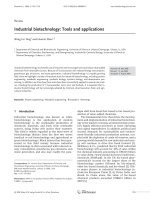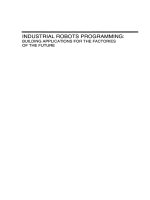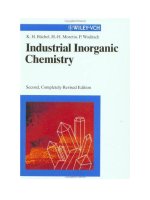Industrial Dyes (Chemistry Properties Applications)
Bạn đang xem bản rút gọn của tài liệu. Xem và tải ngay bản đầy đủ của tài liệu tại đây (8.67 MB, 685 trang )
K. Hunger (Editor)
Industrial Dyes
Chemistry, Properties, Applications
Furtherof Interest:
Herbst, W., Hunger, K.
IndustrialOrganicPigments
Production, Properties
,
Applicat
ions
Third, Completely Revised Edition
2003
ISBN 3-527-30576-9
Buxbaum, G. (Ed.)
IndustrialInorganic Pigments
Second, Completely Revised Edition
1998
ISBN 3-527-28878-3
Smith, H. M. (Ed.)
High Performance Pigments
2002
ISBN 3-527-30204-2
Völz, H. G.
IndustrialColorTesting
Fundamentals and Techniques
Second, Completely Revised Edition
2001
ISBN 3-527-30436-3
Freitag, W., Stoye, D. (Eds.)
Paints, Coatings and Solvents
Second, Completely Revised Edition
1998
ISBN 3-527-28863-5
Bieleman, J. (Ed.)
Additives for Coatings
2000
ISBN 3-527-29785-5
Klaus Hunger (Editor)
Industrial Dyes
Chemistry, Properties, Applications
Dr. Klaus Hunger (Editor)
D-65779 Kelkheim
Germany
formerly Hoechst AG, Frankfurt, Germany
This book was carefully produced. Nevertheless, editor , authors and publisher do not warrant the
information contained therein to be free of errors. Readers are advised to keep in mind that state-
ments,
data, illustrations, procedural details or other items may inadvertently be inaccurate.
Library of Congress Card No.: Applied for.
British Library Cataloguing-in-Publication Data: A catalogue record for this book is available from the
British Library
Bibliographic information published by Die Deutsche Bibliothek
Die Deutsche Bibliothek lists this publication in the Deutsche Nationalbibliografie;
detailed bibliographic data is available in the Internet at <>
ISBN 3-527-30426-6
2003 WILEY-VCH Verlag GmbH & Co. KGaA, Weinheim
Printed on acid-free paper.
All rights reserved (including those of translation in other languages). No part of this book may be
reproduced in any form – by photoprinting, microfilm, or any other means – nor transmitted or trans-
lated into machine language without written permission from the publishers. Registered names,
trade-
marks, etc. used in this book, even when not specifically marked as such, are not to be considered
unpro-
tected by law.
Composition: Kühn & Weyh, 79111 Freiburg
Printing and Bookbinding: Druckhaus Darmstadt GmbH, Darmstadt
Printed in the Federal Republic of Germany.
Johann-Strau -Str. 35
û
Contents
Preface XXI
List of Contributors XXIII
1 Dyes, General Survey 1
1.1 Introduction 1
1.2 Classification Systems for Dyes 2
1.3 Classification of Dyes by Use or Application Method 3
1.4 Nomenclature of Dyes 6
1.5 Equipment and Manufacture 7
1.6 Economic Aspects 10
1.7 References 12
2 Important Chemical Chromophores of Dye Classes 13
Introduction 13
2.1 Azo Chromophore 14
2.1.1 Introduction 14
2.1.2 General Synthesis 16
2.1.2.1 Diazo Components 16
2.1.2.2 Diazotization Methods 19
2.1.2.3 Coupling Components 20
2.1.2.4 Azo Coupling in Practice 28
2.1.3 Principal Properties 29
2.1.3.1 Tautomerism 29
2.1.3.2 Metallized A zo Dyes 32
2.1.3.3 Carbocyclic Azo Dyes 33
2.1.3.4 Heterocyclic Azo Dyes 34
2.1.4 References 35
2.2 Anthraquinone Chromophore 35
2.2.1 Introduction 35
2.2.2 General Synthesis 36
2.2.3 Principal Properties 36
2.2.3.1 Benzodifuranone Dyes 37
2.2.3.2 Polycyclic Aromatic Carbonyl Dyes 38
2.2.4 References 39
2.3 Indigoid Chromophore 40
2.3.1 Introduction 40
2.3.2 General Synthesis 40
2.3.3 Principal Properties 41
2.3.3.1 Color 41
2.3.3.2 Basic Chromophore 42
2.3.3.3 Solvatochromism 42
2.3.3.4 Redox System 43
2.3.4 References 43
2.4 Cationic Dyes as Chromophores 44
2.4.1 Introduction 44
2.4.2 General Synthesis 45
2.4.3 Chemical Structure and Classification 45
2.4.3.1 Dyes with Delocalized Charge 45
2.4.3.2 Dyes with Localized Charge 49
2.4.4 Principal Properties 52
2.4.4.1 Cationic Dyes for Synthetic Fibers 52
2.4.4.2 Cationic Dyes for Paper, Leather, and Other Substrates 53
2.4.5 References 55
2.5 Polymethine and Related Chromophores 56
2.5.1 Introduction 56
2.5.2 General Synthesis 57
2.5.3 Principal Properties and Classification 57
2.5.3.1 Azacarbocyanines 57
2.5.3.2 Hemicyanines 57
2.5.3.3 Diazahemicyanines 58
2.5.3.4 Styryl D yes 58
VI Contents
2.6 Di- and Triarylcarbenium and Related Chromophores 59
2.6.1 Introduction 59
2.6.2 Chromophores 60
2.6.3 General Synthesis 62
2.6.4 Principal Properties 65
2.6.5 References 67
2.7 Phthalocyanine Chromophore 68
2.7.1 Introduction 68
2.7.2 General Synthesis 70
2.7.3 Principal Properties 72
2.7.4 Industrial Production 73
2.7.4.1 Copper Phthalocyanine 73
2.7.4.2 Phthalocyanine Derivatives 74
2.7.4.3 Pthalocyanine Sulfonic Acids and Sulfonyl Chlorides 75
2.7.5 References 76
2.8 Sulfur Compounds as Chromophores 78
2.8.1 Introduction 78
2.8.2 Chromophores 79
2.8.3 General Synthesis 79
2.8.3.1 Sulfur Bake and Polysulfide Bake Dyes 79
2.8.3.2 Polysulfide Melt Dyes 81
2.8.3.3 Pseudo Sulfur Dyes 83
2.8.4 Principal Properties 84
2.8.5 References 84
2.9 Metal Complexes as Chromophores 85
2.9.1 Introduction 85
2.9.2 Azo/Azomethine Complex Dyes 86
2.9.2.1 General Synthesis 86
2.9.2.2 Principal Properties 92
2.9.3 Formazan Dyes 97
2.9.3.1 Introduction 97
2.9.3.2 General Synthesis 98
2.9.3.3 Principal Properties 102
2.9.4 References 105
2.10 Fluorescent Dyes 107
2.11 Other Chromophores 109
2.11.1 Quinophthalone Dyes 109
2.11.2 Nitro and Nitroso Dyes 110
2.11.3 Stilbene D yes 111
2.11.4 Formazan Dyes 111
Contents VII
2.11.5 Triphenodioxazine Dyes 112
2.11.6 References 112
3 Dye Classes For PrincipalApplications 113
3.1 Reactive Dyes 113
3.1.1 Introduction 113
3.1.2 Chemical Constitution of Reactive Systems 114
3.1.2.1 Mono-Anchor Dyes 114
3.1.2.2 Double-Anchor Dyes 117
3.1.2.3 Multiple-Anchor Dyes 118
3.1.3 Dye Classes (Chromogens) for Reactive Dyes 118
3.1.3.1 Azo Dyes 119
3.1.3.2 Metal-Complex Azo Dyes 119
3.1.3.3 Anthraquinone D yes 119
3.1.3.4 Triphenodioxazine Dyes 120
3.1.3.5 Formazan Dyes 122
3.1.3.6 Phthalocyanine Dyes 122
3.1.4 Synthesis 123
3.1.5 Examples of Commercially Available Dyes 129
3.1.5.1 Azo Dyes 129
3.1.5.2 Metal Complex Azo Dyes 130
3.1.5.3 Formazan Dyes 130
3.1.5.4 Anthraquinone D yes 130
3.1.5.5 Diphenodioxazine Dyes 131
3.1.6 Forms of Supply 131
3.1.7 References 132
3.2 Disperse Dyes 134
3.2.1 Introduction 134
3.2.2 Chemical Constitution 135
3.2.2.1 Azo Dyes 135
3.2.2.2 Anthraquinone D yes 138
3.2.2.3 Other Chromophores 139
3.2.3 Synthesis 144
3.2.3.1 Monoazo Dyes 144
3.2.3.2 Disazo Dyes 145
3.2.3.3 Anthraquinone D yes 145
3.2.3.4 Other Chromophores 145
3.2.4 Aftertreatment 145
3.2.5 Examples of Commercially Available Dyes 146
3.2.5.1 Monoazo Dyes 146
3.2.5.2 Disazo Dyes 154
3.2.5.3 Anthraquinone D yes 155
VIII Contents
3.2.5.4 Other Chromophores 155
3.2.6 References 156
3.3 Direct D yes 158
3.3.1 Introduction 158
3.3.2 Chemical Constitution 159
3.3.2.1 Structural Characteristics 159
3.3.2.2 Precursors 159
3.3.2.3 Classification According to the Method of Application 161
3.3.3 Dye Classes 161
3.3.3.1 Monoazo Dyes 161
3.3.3.2 Disazo Dyes 162
3.3.3.3 Trisazo Dyes 164
3.3.3.4 Tetrakisazo Dyes 165
3.3.4 Synthesis 168
3.3.4.1 Monoazo Dyes 168
3.3.4.2 Disazo Dyes 169
3.3.4.3 Trisazo Dyes 170
3.3.4.4 Anthraquinone D irect Dyes 172
3.3.5 Direct D yes with Aftertreatment 172
3.3.5.1 Aftertreatment with Cationic Auxiliaries 173
3.3.5.2 Aftertreatment with Formaldehyde 174
3.3.5.3 Diazotization Dyes 174
3.3.5.4 Aftertreatment with Metal Salts 175
3.3.6 Examples of Commercially Available Dyes 175
3.3.6.1 Monoazo Dyes 175
3.3.6.2 Disazo Dyes 176
3.3.6.3 Trisazo Dyes 176
3.3.6.4 Tetrakisazo Dyes 176
3.3.6.5 Condensation Dyes 177
3.3.6.6 Direct D yes with a Urea Bridge 177
3.3.6.7 Triazinyl Dyes 177
3.3.7 References 178
3.4 Anthraquinone D yes 178
3.4.1 Introduction 178
3.4.2 Chemical Constitution and Properties 180
3.4.2.1 Disperse Dyes 180
3.4.2.2 Vat Dyes 187
3.4.2.3 Acid Dyes 195
3.4.3 Synthesis 200
3.4.3.1 Introduction 200
3.4.3.2 Anthraquinonesulfonic Acids 200
3.4.3.3 Haloanthraquinones 201
3.4.3.4 Nitroanthraquinones 201
3.4.3.5 Aminoanthraquinones 201
Contents IX
3.4.3.6 Hydroxyanthraquinones 202
3.4.4 Examples of Commercially Available Dyes 202
3.4.5 References 203
3.5 Indigoid Dyes 204
3.5.1 Introduction 204
3.5.2 Chemical Constitution and Properties 205
3.5.2.1 Physical Properties 205
3.5.2.2 Chemical Properties 206
3.5.3 Synthesis 207
3.5.3.1 Chemical Synthesis 207
3.5.3.2 Biotechnological Synthesis 211
3.5.4 Commercially Available Dyes 213
3.5.4.1 Indigo, C.I. Vat Blue 1, 73000, [482-89-3] 213
3.5.4.2 Halogen Derivatives 213
3.5.4.3 Other Indigo Derivatives 214
3.5.5 References 214
3.6 Sulfur Dyes 215
3.6.1 Introduction 215
3.6.2 Chemical Constitution 216
3.6.3 Synthesis 216
3.6.3.1 Sulfur and Polysulfide Bake or Dry Fusion 216
3.6.3.2 Polysulfide Melt, Solvent Reflux, or Reflux Thionation Process 219
3.6.3.3 Indophenols 219
3.6.4 Modifications; Commercial Forms; Types of Sulfur Dyes 223
3.6.4.1 C.I. Sulphur Dyes 224
3.6.4.2 C.I. Leuco Sulphur Dyes 224
3.6.4.3 C.I. Solubilised Sulphur Dyes
(Bunte Salts, S-Aryl Thiosulfate Dyes) 224
3.6.5 Pseudo (Synthetic) Sulfur Dyes 225
3.6.6 Commercially Available Dyes 226
3.6.7 References 226
3.7 Cationic Azo Dyes 227
3.7.1 Introduction 227
3.7.2 Chemical Constitution and Synthesis 227
3.7.2.1 Cationic Charge in the Coupling Component 227
3.7.2.2 Cationic Charge in the Diazo Component 237
3.7.2.3 Different Cationic Charges in Both the Coupling and the Diazo
Component 244
3.7.2.4 Introduction of Cationic Substituents into Preformed Azo Dyes 245
3.7.2.5 Cationic Dyes with Sulfur or Phosphorus as Charge-Carrying
Atoms 246
3.7.2.6 Dyes with Releasable Cationic Groups 247
X Contents
3.7.3 Synthesis 248
3.7.4 Examples of Commercially Available Dyes 248
3.7.5 References 250
3.8 Cationic Methine Dyes 254
3.8.1 Introduction 254
3.8.2 Chemical Constitution and Synthesis 254
3.8.2.1 Streptocyanine Dyes 254
3.8.2.2 Hemicyanine Dyes 255
3.8.2.3 Higher Vinylogues of Hemicyanine Dyes 260
3.8.2.4 Phenylogous Hemicyanine Dyes 261
3.8.2.5 Cyanine Dyes 268
3.8.3 Synthesis 271
3.8.4 Examples of Commercially Available Dyes 272
3.8.5 References 273
3.9 Acid Dyes (Anionic Azo Dyes) 276
3.9.1 Introduction 276
3.9.2 Chemical Constitution and Synthesis 277
3.9.2.1 Wool Dyes 278
3.9.2.2 Polyamide Dyes 289
3.9.2.3 Silk Dyes 291
3.9.3 Examples of Commercially Available Dyes 291
3.9.4 References 294
3.10 Solvent Dyes 295
3.10.1 Introduction 295
3.10.2 Chemical Constitution and Application Properties 295
3.10.2.1 Alcohol- and Ester-Soluble Dyes 295
3.10.2.2 Fat- and Oil-Soluble Dyes 297
3.10.2.3 Dyes Soluble in Polymers 298
3.10.2.4 Solvent Dyes for Other Applications 299
3.10.3 Examples of Commercially Available Dyes 300
3.10.4 References 301
3.11 Metal-Complex Dyes 302
3.11.1 Introduction 302
3.11.2 Chemical Constitution and Synthesis 304
3.11.2.1 Chromium and Cobalt Complexes for Wool and Polyamides 304
3.11.2.2 Metal Complexes for Cotton (see also Section 3.1) 311
3.11.2.3 Metal Complexes for Leather (see also Section 5.1) 313
3.11.2.4 Copper Complexes for Paper (see also Section 5.3) 315
3.11.2.5 Metal-Complex Dyes for Polypropylene 316
3.11.2.6 Formazan Dyes 316
3.11.3 Miscellaneous U ses 319
Contents XI
3.11.3.1 Azo Metal-Complex D yes 319
3.11.3.2 Formazan Dyes 324
3.11.4 References 327
3.12 Naphthoquinone and Benzoquinone Dyes 329
3.12.1 Introduction 329
3.12.2 Benzoquinone D yes 330
3.12.3 1,4-Naphthoquinone Dyes 331
3.12.3.1 Simple 1,4-Naphthoquinones 331
3.12.3.2 Heteroannelated 1,4-Naphthoquinones 332
3.12.4 1,5-Naphthoquinones 335
3.12.5 References 338
4 Textile Dyeing 339
4.1 Introduction 339
4.1.1 Dyeing Technology 340
4.1.1.1 Principles of Dyeing 341
4.1.1.2 Bath Dyeing Technology 342
4.1.1.3 Continuous and Semicontinuous Dyeing 343
4.1.1.4 Printing 345
4.1.1.5 Dispensing Dyes and Chemicals 345
4.1.2 Standardization of Textile Dyes 346
4.1.3 Colorfastness of Textiles 348
4.1.4 Laboratory Dyeing Techniques 349
4.2 Reactive Dyes on Cellulose and Other Fibers 349
4.2.1 Fundamentals 350
4.2.2 Dyeing Techniques for Cellulose 353
4.2.3 Reactive Dyes on Wool, Silk and Polyamide Fibers 356
4.2.4 Reactive Dyes for Printing on Cellulose 357
4.3 Direct D yes on Cellulosic Fibers 358
4.3.1 Dyeing Principle 358
4.3.2 Dyeing Parameters 359
4.3.3 Dyeing Techniques 360
4.3.4 Aftertreatment 361
4.3.5 Direct D yes for Fiber Blends 361
4.4 Anthraquinone Vat Dyes on Cellulosic Fibers 362
4.4.1 Principles of Vat Dyeing 362
4.4.2 The Vat Dyeing Process 363
4.4.2.1 Vatting 363
4.4.2.2 Dye Absorption in the Exhaustion Process 364
XII Contents
4.4.2.3 Oxidation 364
4.4.2.4 Aftertreatment (“Soaping”) 365
4.4.3 Dyeing Techniques 365
4.4.4 Vat Dyes for Fiber Blends 367
4.5 Leuco Esters of Vat Dyes on Cellulosic Fibers 367
4.6 Dyeing with Indigo (see 2.3, 3.5) 368
4.6.1 Dyeing Technique on Cotton 368
4.6.2 Indigo on Wool 369
4.7 Sulfur Dyes on Cellulosic Fibers 370
4.7.1 Types and Mode of Reaction 370
4.7.2 Additives to the Dye Bath 371
4.7.3 The Dyeing Process 372
4.7.4 Dyeing Techniques 373
4.7.5 Combination with O ther Dyes 375
4.8 Azo (Naphtol AS) Dyes on Cellulosic Fibers 375
4.8.1 Application of Azo Dyes 375
4.8.2 Dyeing Processes on Cellulosic Fibers 376
4.8.3 Printing with Azo (Naphtol A S) Dyes on Cellulosic Fibers 377
4.9 Dyeing Cellulosic Fibers with Other Dye Classes 377
4.9.1 Mordant Dyes on Cellulosic Fibers 377
4.9.2 Acid Dyes on Plant Fibers 378
4.9.3 Basic Dyes on Cellulose 378
4.9.4 Oxidation Dyes on Cellulosic Fibers 378
4.9.5 Phthalogen Dyes on Cellulosic Fibers 379
4.9.6 Coupling and Diazotization D yes on Cellulosic Fibers 379
4.9.7 Pigments and Mineral Dyes on Cellulose 380
4.10 Acid and Metal-Complex Dyes on Wool and Silk 381
4.10.1 Principles of Dyeing of Wool and Silk 381
4.10.2 Acid Dyes on Wool 382
4.10.3 Chrome Dyes on Wool 384
4.10.4 Metal-Complex Dyes on Wool 385
4.10.4.1 1:1 Metal-Complex Dyes 385
4.10.4.2 1:2 Metal-Complex Dyes 386
4.11 Acid and Metal-Complex Dyes on Polyamide 386
4.11.1 Chemical and Physical Structure of the Fiber 386
4.11.2 Interactions Between Dye and Fiber 387
4.11.3 Dyeing Processes with Different Classes of Dyes 388
4.11.3.1 Acid Dyes 388
Contents XIII
4.11.3.2 1:2 Metal-Complex Dyes 390
4.11.4 Technology of Dyeing Polyamide 391
4.12 Disperse Dyes on Polyester and Other Man-Made Fibers 392
4.12.1 General A spects 392
4.12.1.1 Dyeing in Aqueous Liquor 392
4.12.1.2 Thermosol Process 395
4.12.2 Dyeing Processes for Polyester Fibers with Disperse Dyes 396
4.12.2.1 Suitability of Disperse Dyes for Different Applications 396
4.12.2.2 Dyeing from Aqueous Dye Baths 397
4.12.2.3 Special Dyeing Processes 398
4.12.2.4 Continuous and Semicontinuous D yeing Processes 399
4.12.2.5 Dyeing of PES Microfibers 400
4.12.2.6 Dyeing of Modified PES Fibers 401
4.12.2.7 Printing wth Disperse Dyes on Man-Made Fibers 401
4.12.3 Aftertreatment 403
4.12.4 Dyeing Blends Containing Polyester Fibers 403
4.12.4.1 Polyester–Cellulose Blends 403
4.12.4.2 Polyester–Wool Blends 407
4.13 Disperse Dyes on Other Fibers 409
4.13.1 Disperse Dyes on Cellulose Acetate 409
4.13.1.1 Dyeing Processes for Cellulose 2.5 A cetate 409
4.13.1.2 Dyeing Processes for Cellulose Triacetate 410
4.13.2 Disperse Dyes on Polyamide Fibers 410
4.13.3 Disperse Dyes on Other Fibers 411
4.14 Cationic Dyes on Acrylic Fibers 412
4.14.1 General A spects 412
4.14.2 Cationic Dyes 412
4.14.3 Retarders and Auxiliaries 413
4.14.4 Exhaustion Process 414
4.14.5 Dyeing of Special Fiber Types with Cationic Dyes by the
Exhaustion Process 416
4.14.6 Continuous Processes with Cationic Dyes 417
4.14.7 Cationic Dyes on Aramide Fibers 418
4.14.8 Cationic Dyes in Fiber Blends 419
4.15 References 421
5 Nontextile Dyeing 427
5.1 Leather Dyes 427
5.1.1 Introduction 427
XIV Contents
5.1.2 Color Selection 428
5.1.2.1 Aniline Leather 428
5.1.2.2 Pigmented Leather 429
5.1.2.3 Colour Index 429
5.1.3 Natural and Mordant Dyes 431
5.1.3.1 Tanning Agents 431
5.1.3.2 Dyewood 432
5.1.3.3 Synthetic Mordant Dyes 433
5.1.4 Basic Dyes 433
5.1.4.1 Azine Dyes 433
5.1.4.2 Other Cationic (Basic) Dyes 434
5.1.5 Acid Dyes 434
5.1.5.1 Amphoteric Dyes 435
5.1.5.2 Anthraquinone D yes 435
5.1.5.3 Low-Molecular Azo Dyes 436
5.1.5.4 Resorcinol Azo Dyes 437
5.1.5.5 Azo Metal-Complex Dyes 437
5.1.6 Direct D yes 439
5.1.6.1 Condensation Dyes 439
5.1.6.2 Polyazo Dyes 440
5.1.6.3 Phthalocyanine Dyes 440
5.1.7 Sulfur Dyes 441
5.1.8 Reactive Dyes 442
5.1.9 Solvent Dyes 443
5.1.10 Pigments 444
5.1.11 References 445
5.2 Fur Dyes 446
5.2.1 Introduction 446
5.2.1.1 Origin of Fur 446
5.2.1.2 Animal Rights 447
5.2.1.3 Fur Hair and Classification 448
5.2.1.4 Fur Dressing 448
5.2.1.5 Fur Finishing 448
5.2.1.6 The Final Stage 449
5.2.1.7 Garments and Fashion 450
5.2.1.8 Labels 450
5.2.2 Fur Dyeing 451
5.2.2.1 History and Outlook 451
5.2.2.2 Color Selection and Colour Index 451
5.2.2.3 Vegetable Dyes 451
5.2.2.4 Oxidation Bases 452
5.2.2.5 Disperse Dyes 453
5.2.2.6 Acid and Direct Dyes 454
5.2.2.7 Metal-Complex Dyes 456
Contents XV
5.2.2.8 Other Synthetic Dyes 457
5.2.3 References 458
5.3 Paper Dyes 459
5.3.1 Introduction 459
5.3.2 Classification of Paper Dyes 460
5.3.3 Direct D yes 460
5.3.3.1 Anionic Direct Dyes 461
5.3.3.2 Cationic Direct Dyes 466
5.3.4 Acid Dyes 469
5.3.5 Cationic (Basic) Dyes 470
5.3.6 Sulfur Dyes 471
5.3.7 Organic Pigments 472
5.3.8 Special Requirements for Paper Dyes 472
5.3.9 References 472
5.4 Hair Dyes 473
5.4.1 Bleaching 473
5.4.2 Dyeing with Oxidation Dyes 475
5.4.3 Dye Classes 479
5.4.3.1 Direct D yes 479
5.4.3.2 Nitro Dyes 479
5.4.3.3 Cationic (Basic) Dyes (see Sections 3.7 and 3.8) 480
5.4.3.4 Anionic (Acid) Dyes (see Section 3.9) 480
5.4.3.5 Disperse Dyes (see Section 3.2) 480
5.4.3.6 Dyeing with Inorganic Compounds 480
5.4.3.7 Other Dyes 481
5.4.4 Product Forms 481
5.4.5 Dye-Removal Preparations 483
5.4.6 Testing Hair Dyes 483
5.4.7 References 484
5.5 Food Dyes 486
5.5.1 Introduction 486
5.5.1.1 Specifications 487
5.5.1.2 Uses and Individual Substances 487
5.5.2 Synthetic Dyes Approved for Coloring of Foodstuffs 487
5.5.3 Examples of Chemical Structures 489
5.5.4 Purity Requirements 491
5.5.5 Legal Aspects 492
5.5.5.1 Codex Alimentarius 492
5.5.5.2 EU and other European Countries 492
5.5.5.3 USA 493
5.5.5.4 Japan 494
5.5.6 References 494
XVI Contents
5.6 Ink Dyes 495
5.6.1 Introduction 495
5.6.2 Application Principles 495
5.6.2.1 Ink-Jet Technology 495
5.6.2.2 Writing, Drawing and Marking Materials 497
5.6.3 Dye Classes 497
5.6.3.1 Dyes for Ink-Jet Application 497
5.6.3.2 Dyes for Writing, Drawing, and Marking 501
5.6.3.3 Fields of Application for Ink-Jet Printing 502
5.6.4 Inks 503
5.6.4.1 Ink-Jet Inks 503
5.6.4.2 Writing, Drawing, and Marking Inks 505
5.6.5 Properties of Ink-Jet Prints 507
5.6.6 References 508
5.7 Photographic Dyes 509
5.7.1 Cyanine Dyes 509
5.7.1.1 Introduction 509
5.7.1.2 Fundamental Aspects 509
5.7.1.3 Application of Sensitizing Dyes 511
5.7.1.4 Production of Sensitizing Dyes 512
5.7.1.5 Cyanine Dyes as Sensitizers 512
5.7.2 Merocyanine Dyes 515
5.7.3 Oxonol Dyes 516
5.7.4 Azomethine and Indoaniline Image Dyes 516
5.7.4.1 Introduction 516
5.7.4.2 Color Developers 517
5.7.4.3 Yellow Azomethine Dyes 517
5.7.4.4 Magenta Azomethine Dyes 518
5.7.4.5 Cyan Indoaniline Dyes 518
5.7.5 Azo Dyes 519
5.7.5.1 Diffusion-Transfer Imaging Systems 519
5.7.5.2 Silver Dye Bleach Processes 520
5.7.5.3 Color Masking 520
5.7.6 Metallized D yes 521
5.7.7 Xanthene Dyes 521
5.7.8 Triarylmethane Dyes 522
5.7.9 Anthraquinone D yes 523
5.7.10 References 523
5.8 Indicator Dyes 526
5.8.1 Introduction 526
5.8.2 General Principles 526
5.8.3 Classes of Indicators 527
5.8.3.1 ph Indicators 527
Contents XVII
5.8.3.2 Redox Indicators 537
5.8.3.3 Metal Indicators 537
5.8.4 Indicator Papers 540
5.8.4.1 Bleeding Indicator Papers 540
5.8.4.2 Nonbleeding Indicator Papers 541
5.8.5 References 541
6 Functional Dyes 543
6.1 Introduction 543
6.2 Interactions of Functional Dyes 543
6.3 Functional Dyes by Application 545
6.3.1 Imaging 545
6.3.1.1 Laser Printing and Photocopying 545
6.3.1.2 Thermal Printing 551
6.3.1.3 Dyes for Ink-Jet Printing 555
6.3.1.4 Other Imaging Technologies 558
6.3.2 Invisible Imaging 559
6.3.2.1 Optical Data Storage 560
6.3.2.2 Other Technologies 564
6.3.3 Displays 566
6.3.3.1 Cathode Ray Tube 566
6.3.3.2 Liquid Crystal Displays 566
6.3.3.3 Organic Light-Emitting Devices 569
6.3.3.4 Electrochromic Displays 571
6.3.4 Electronic Materials 572
6.3.4.1 Organic Semiconductors 572
6.3.4.2 Solar Cells 573
6.3.4.3 Nonlinear Optical Dyes 574
6.3.4.4 Laser Dyes 576
6.3.5 Biomedical Applications 576
6.3.5.1 Fluorescent Sensors and Probes 577
6.3.5.2 Photodynamic Therapy 579
6.4 References 581
7 Optical Brighteners 585
7.1 Introduction 585
7.1.1 Physical Principles 586
7.1.2 Molecular Structure 588
XVIII Contents
7.1.3 History of Whitening 589
7.2 Chemistry of Technical Products 590
7.2.1 Carbocycles 590
7.2.1.1 Distyrylbenzenes 590
7.2.1.2 Distyrylbiphenyls 592
7.2.1.3 Divinylstilbenes 593
7.2.2 Triazinylaminostilbenes 593
7.2.3 Stilbenyl-2 H-triazoles 596
7.2.3.1 Stilbenyl-2 H-naph
tho[1,2-
d]triazoles 597
7.2.3.2 Bis(1,2,3-triazol-2-yl)stilbenes 597
7.2.4 Benzoxazoles 598
7.2.4.1 Stilbenylbenzoxazoles 598
7.2.4.2 Bis(benzoxazoles) 599
7.2.5 Furans,
Benzo[
b]furans, and Benzimidazoles 601
7.2.5.1
Bis(ben zo[
b]furan-2-yl)biphenyls 601
7.2.5.2 Cationic Benzimidazoles 602
7.2.6 1,3-Diphenyl-2-pyrazolines 605
7.2.7 Coumarins 607
7.2.8 Naphthalimides 608
7.2.9 1,3,5-Triazin-2-yl Derivatives 610
7.3 Commercial Forms and Brands 610
7.4 Uses 611
7.4.1 General Requirements 611
7.4.2 Textile Industry 611
7.4.3 Detergent Industry 613
7.4.4 Paper Industry 614
7.4.5 Plastics and Synthetic Fibers 614
7.4.6 Other Uses 615
7.5 Analytical Methods and Whiteness Assessment 615
7.5.1 Analytical Methods 615
7.5.2 Assessment of Whitening Effect 616
7.6 Environmental A spects 616
7.7 References 617
8 Health and Safety Aspects 625
8.1 Introduction 625
Contents XIX
8.2 Toxicology and Toxicity Assessments 626
8.2.1 Acute Toxicity 626
8.2.2 Sensitization 626
8.2.3 Mutagenicity 628
8.2.4 Carcinogenicity 629
8.2.4.1 Introduction 629
8.2.4.2 Metabolism of Azo Dyes 630
8.3 Environmental A ssessment /Fate 633
8.3.1 Introduction 633
8.3.2 Treatment of Dye-Containing Wastewater 633
8.4 Legislation 634
8.4.1 Registration / Notification of New Substances 634
8.4.2 Principal Chemical Legislation also Relevant to Dyes 635
8.4.3 Special Regulations for Dyes (Colorants) 636
8.4.4 Material Safety D ata Sheets 638
8.5 References 639
8.5.1 General References 639
8.5.2 Specific References 639
List of Examples of Commercially AvailableDyes 643
Index 653
XX Contents
Preface
A great deal of single papers on color chemistry have been published over the
years. Their subjects are preferably theoretical or physico-chemical
considera-
tions of dye chemistry. On the other hand, the knowledge of dye chemistry
from
a technical point of view is almost entirely concentrated in the chemical
industry.
Apart from lectures given at the very few conferences on color chemistry,
the cur-
rent state of industrial dye chemistry can only be extracted from the patent
litera-
ture. There is little else being published on dyes, especially on industrial
dyes and
their applications.
This prompted us to write a reference book comprising the principal classes of
industrially produced dyes with their syntheses, properties and main
applications as
well as a toxicological, ecological and legal survey of dyes.
Since the field of dyes has grown so big in recent decades, it cannot be
comprehen-
sively covered by one or only a few persons. The various authors are
renowned
experts in their different fields of dye chemistry, which guarantees most
competent
contributions to this book.
The book provides an overview of the present state of industrial dyes and is
divided
into the following chapters: After a general survey on dyes, important dye
chromo-
phores are covered in chapter 2, followed by classification of dyes for principal
appli-
cations. Chapter 4 is devoted to textile dyeing with regard to the various dye
classes.
Non-textile dyeing is outlined in the next chapter. Because of their growing potential
and interest, functional dyes are reviewed in a separate chapter. Optical
brighteners
make up chapter 7, and a general overview on the toxicology, ecology and
legislation
of dyes forms the final chapter 8.
The literature references relating to each chapter are positioned at their respective
ends.
A comprehensive subject index should enable the reader to quickly find any
sought
item.
We omitted to use trade names, but tried to designate the dyes with the C.I.
Colour
Index Name, and where available, with the C.I. Constitution Number and with the
CAS (Chemical Abstracts Service) Registry Number.
This book is intended for all those who are engaged and interested in the field of
industrial dyes, especially chemists, engineers, application technicians, colorists
and
laboratory assistants throughout the dye industry and at universities and technical
col-
leges.
I am very grateful to the authors for their dedicated cooperation for this book. My
appreciation is also extended to the Wiley-VCH publishing company for its good col-
laboration, in particular to Ms. Karin Sora, for her support in numerous
discussions
throughout the project.
Kelkheim, November 2002 Klaus Hunger
XXII Preface
List of Contributors
Editor
Dr. K. Hunger
65779 Kelkheim/Ts.
Germany
formerly
Hoechst Aktiengesellschaft
Geschäftsbereich
Feinchemikalien und Farben
65926 Frankfurt am Main
Germany
Sections 2.1 (G regory), 2.7, 3.1, 3.2, 3.3,
3.8, 3.9, 3.10, 3.12, 5.5,
Chapter 8 (Sewekow)
Authors
Dr. W. Bauer
Masurenstr.6
63477 Maintal
Germany
Section 5.6
Dr. H. Berneth
Bayer AG
Farbenforschung SP-FE-PE
Geb. I1
51368 Leverkusen
Germany
Section 2.4
Dr. T. Clausen
Wella AG
Geschäftsleitung
Berliner Allee 65
64274 Darmstadt
Germany
Section 5.4
Dr. A. Engel
R & D PTD DyStar Textilfarben
GmbH & Co.
Deutschland KG
Kaiser-Wilhelm Allee
P.O. Box 100480
57304 Leverkusen
Germany
Section 3.7 (Hunger, Kunde)
Dr. M. Filosa
Polaroid Research Laboratories
Polaroid Corporation
Cambridge, MA 02139
USA
Section 5.7
Dr. P. Gregory
Avecia Research Center
Avecia Ltd.
Blackley Manchester M9 8ZS
UK
Sections 2.1 (H unger), 2.2, 2.5, 2.6,
2.10, 2.11, Chapter 6
Johann-Strau -Str. 35
û
XXIV List of Contributors
Dr. J. Griffiths
The University of Leeds
Dept. of Colour Chemistry
Leeds LS2 9JT
UK
Section 3.12 (Hunger)
Dr. R. Hamprecht
DyStar Textilfarben GmbH & Co.
Deutschland KG
BU D-F & E, Geb. 11
51304 Leverkusen
Germany
Section 3.2
Dr. C. Heid
Lauterbacher Str.10
60386 Frankfurt
Germany
Sections 2.8, 3.6
Dr. J. Kaschig
Ciba Speciality Chemicals
K-24.4.18
Klybeckstrasse
CH-4002 Basel
Switzerland
Chapter 7
Dr. K. Kunde
Bayer AG
SP-FE-PV 1
51368 Leverkusen
Section 3.7 (Engel, Hung er)
Dr. H. Leube
Grünberger Str. 6
67117 Limburgerhof
Germany
Chapter 4
Dr. W. Mennicke
Steglitzer Str. 8
51375 Leverkusen
Germany
Sections 2.9, 3.11
Dr. P. Miederer
BASF AG,
Abt.EFF/AI - D 306
67056 Ludwigshafen
Germany
Sections 2.3, 3.5
Dr. R. Pedrazzi
Clariant (Schweiz) AG
Head R&D D ystuffs
Rothausstr. 61
CH-4132 Muttenz
Switzerland
Section 5.3
Dr. A. G. Püntener
TLF France S. A.
4, rue de l
’industrie
Boite Postale 310
F-68333 Huningue Cedex
France
Sections 5.1, 5.2
Dr. E. Ross
Merck KGaA
USF/ZRW
64271 Darmstadt
Germany
Section 5.8
Dr. Sewekow
Bayer AG, GB Farben Marketing
Allg.Technik
51368 Leverkusen
Germany
Chapter 8 (Hunger)









